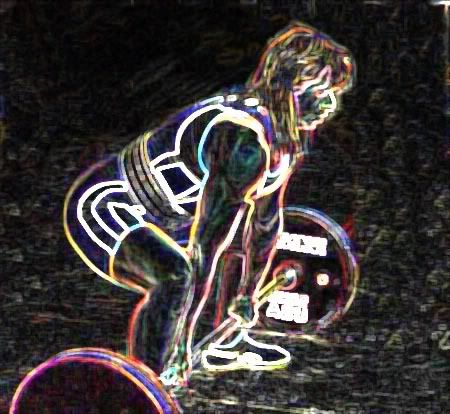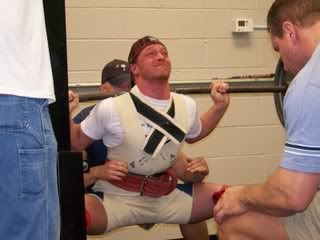Post by Neversatisfied on May 19, 2007 23:31:44 GMT -5
By J. M. Blakely
In all extreme sports (and powerlifting is one of the most extreme) athletes will pull risky hi-jinks and shenanigans to achieve competitive success. Absolutely none of the methods outlined here are being advocated, encouraged, advised, or suggested by the author. This article will explain and outline some of the practices but endorses none of them. Just because your friends jump off a bridge doesn’t mean you should, too. I believe that your mother and I would agree on this point.
What can be gained, or lost?
As an example let’s take an athlete who weighs 226 lbs. and wants to cut to the 100-kg class (220.5 lbs.). He has 2 weeks before his meet and has several options. His first option is to restrict calories and do lots of cardio and burn off 6 pounds of bodyfat and actually weigh 220. We’ll call this the “hard way.” This has two big drawbacks, though. First he will be starving during the last (and most critical) two weeks of training and his energy and intensity will be compromised. Anyone who has tried to train heavy while dieting knows the inherent difficulty in this. An athlete needs fuel to perform well. Secondly, there is no real advantage to this method. He will actually weigh 220 just like everyone else in the class.
Another option is to cut weight. We’ll call this the “quick way” (we certainly can’t call it easy). This takes about two days and will not cause any detriment to training. He can dehydrate and then quickly re-hydrate after the weigh-in and due to an effect known as a “rebound” actually compete at 226 or heavier! An added benefit is that during reconstitution (forced eating and drinking) the muscles will actually retain more glycogen (stored carbohydrate in the muscle) than usual. They will be “Superfueled.” The athlete has to go hungry and thirsty for about a day but in the end he will actually come out way ahead. He competes at 226 in the 220 class and has muscles full to the brim with glycogen and water. That’s the edge!
Why does it work?
In powerlifting the meets are set up with an early weigh-in. The rulebook for most federations (APF included) calls for 24-hour weigh-in. All sanctioned meets will arrange for this. The early weigh-in is why it all works. A day without food or water will create a situation of depletion such that when fluids and food are reintroduced, the body overcompensates and stores more carbohydrate in the muscles. Additionally, the cells also hold extra water to create what is known as tissue leverage which is very advantageous to lifting. Tissue pressure or leverage can markedly improve one’s numbers. This rebound effect cannot be achieved without first creating a depleted state. If the athlete did not deplete and just gorged on food and fluid the same effect would not occur. Extreme depletion causes overcompensation.
How do they do it?
Assuming the meet is at 10:00 a.m. on Saturday, the athlete will prepare for a Friday weigh-in at 10:00 a.m. The lifter would eat a final meal at 10:00 a.m. Thursday. This meal should be light and low in fat and consist mainly of complex carbohydrates. Also, the last drink can be taken and usually is Gatorade. Usually approximately 32 oz. with possibly some extra electrolytes (sodium, potassium, calcium and magnesium) is consumed. This effectively begins a one day fast. Here’s why it makes sense: the adult male can hold 7-13 pounds of partially digested food in the 30 feet of intestines. This varies depending on how big the individual is, how much they normally eat, and their bathroom habits (bowel movements). The food in the gut is liquid and called chime. It is on its way to the colon where bile salts will be reabsorbed and water will the extracted to harden the stool. The truth is that almost all the nutrition has already been absorbed and all this chime is just waiting to become a turd. It is essentially dead weight. It is of no benefit to lifting. It fills the bowel and while it weighs something (7-13 lbs.) it doesn’t aid performance.
A seasoned lifter will reason that by cutting off the input to the 30 feet of bowel (fasting) and emptying the 30 feet of bowel (using a mild laxative) the weight of the chime can be eliminated prior to stepping on the scale. Cleansing the bowel (just as routinely done in medical procedures) is harmless and rids the body of several pounds. Often this is enough to make the class. The choice of laxative and the dosage are important and in extreme cases can upset the electrolytes and cause problems. But mild use is what we are talking about here.
The timing is important and can be unpredictable. Some athletes respond quickly and for others it takes many hours to get the effect. Trial and error may be required. TRY ANY LAXATIVE 2-3 WEEKS IN ADVANCE TO DETERMINE HOW YOUR BODY WILL REACT. Note the amount of time it takes to achieve a bowel movement after taking the laxative. For most athletes, using a laxative on Thursday afternoon, a few hours after the last meal, is the best scenario. Do not wait too long. You do not want the laxative to still be working after the weigh-in when you are trying to eat back up past your weight limit! That is counterproductive. Timing is critical and experience of utmost value.
After the athlete has successfully made weight the fun begins. A feast of foods high in salt and carbohydrate is undertaken. Sweet and salty is a good description of the reconstitution diet. Avoid high fat and high fiber foods as both slow digestion and will dull the supercompensation effect. Forcing food is fun, at first. But in reality it is very tough to keep eating when you are full. Athletes who do not have the discipline to fully reconstitute suffer in impaired performance. For them, cutting weight is a mistake.
The fasting is not nearly as hard on the athlete as is the water restriction. A 24-hour restriction is tough both mentally and physically. Some athletes use diuretics and sweating techniques to push out unbelievable amounts of water (up to 25 pounds in 50 hours) but a simple restriction should not cause any electrolyte disturbances or cramping as is seen in the extreme scenarios. The body is always losing water from urine, sweating, even from breathing. By not allowing any water into the body a loss of several pounds will be realized in one day.
If the athlete expects a good result in competition, he must fully replenish all of the fluids that were temporarily lost. Just how much fluid was lost? If the athlete loses 5 lbs. from fluid, then 5 pounds or 10 8 oz. glasses of water must be consumed. The athlete should begin to drink immediately after stepping off of the scale at the weigh-in. For losses of less than 10 pounds, water is all that is required. The athlete must continue to force fluids until the urine becomes crystal clear. The color of urine is a marker of its dilution. If the urine is dark and yellow it is concentrated and the body is still in need of hydration. The kidneys are concentrating the urine to conserve water. But if the urine is clear it is dilute and the kidneys are pushing out the same amount of waste but with copious amounts of water, too.
Cutting weight is a method of very quickly emptying the bowel and dehydrating the body to make a lighter weight class and then just as rapidly replenishing the food and fluid to return the bodymass back to the original weight or even higher. It should be done in two days—one day to lose it and one day to regain it. The most important factor for success is to fully reconstitute the fluids and fuel.
Cutting weight is no joke and can have very serious consequences. If the athlete is not in excellent health or has heart or kidney problems it is foolhardy to attempt even a small cut. Cutting weight certainly gives a competitive edge to those in the know. The more drastic the cut, the more risks involved. Every athlete must balance the risks and benefits to any competitive endeavor for themselves.
In all extreme sports (and powerlifting is one of the most extreme) athletes will pull risky hi-jinks and shenanigans to achieve competitive success. Absolutely none of the methods outlined here are being advocated, encouraged, advised, or suggested by the author. This article will explain and outline some of the practices but endorses none of them. Just because your friends jump off a bridge doesn’t mean you should, too. I believe that your mother and I would agree on this point.
What can be gained, or lost?
As an example let’s take an athlete who weighs 226 lbs. and wants to cut to the 100-kg class (220.5 lbs.). He has 2 weeks before his meet and has several options. His first option is to restrict calories and do lots of cardio and burn off 6 pounds of bodyfat and actually weigh 220. We’ll call this the “hard way.” This has two big drawbacks, though. First he will be starving during the last (and most critical) two weeks of training and his energy and intensity will be compromised. Anyone who has tried to train heavy while dieting knows the inherent difficulty in this. An athlete needs fuel to perform well. Secondly, there is no real advantage to this method. He will actually weigh 220 just like everyone else in the class.
Another option is to cut weight. We’ll call this the “quick way” (we certainly can’t call it easy). This takes about two days and will not cause any detriment to training. He can dehydrate and then quickly re-hydrate after the weigh-in and due to an effect known as a “rebound” actually compete at 226 or heavier! An added benefit is that during reconstitution (forced eating and drinking) the muscles will actually retain more glycogen (stored carbohydrate in the muscle) than usual. They will be “Superfueled.” The athlete has to go hungry and thirsty for about a day but in the end he will actually come out way ahead. He competes at 226 in the 220 class and has muscles full to the brim with glycogen and water. That’s the edge!
Why does it work?
In powerlifting the meets are set up with an early weigh-in. The rulebook for most federations (APF included) calls for 24-hour weigh-in. All sanctioned meets will arrange for this. The early weigh-in is why it all works. A day without food or water will create a situation of depletion such that when fluids and food are reintroduced, the body overcompensates and stores more carbohydrate in the muscles. Additionally, the cells also hold extra water to create what is known as tissue leverage which is very advantageous to lifting. Tissue pressure or leverage can markedly improve one’s numbers. This rebound effect cannot be achieved without first creating a depleted state. If the athlete did not deplete and just gorged on food and fluid the same effect would not occur. Extreme depletion causes overcompensation.
How do they do it?
Assuming the meet is at 10:00 a.m. on Saturday, the athlete will prepare for a Friday weigh-in at 10:00 a.m. The lifter would eat a final meal at 10:00 a.m. Thursday. This meal should be light and low in fat and consist mainly of complex carbohydrates. Also, the last drink can be taken and usually is Gatorade. Usually approximately 32 oz. with possibly some extra electrolytes (sodium, potassium, calcium and magnesium) is consumed. This effectively begins a one day fast. Here’s why it makes sense: the adult male can hold 7-13 pounds of partially digested food in the 30 feet of intestines. This varies depending on how big the individual is, how much they normally eat, and their bathroom habits (bowel movements). The food in the gut is liquid and called chime. It is on its way to the colon where bile salts will be reabsorbed and water will the extracted to harden the stool. The truth is that almost all the nutrition has already been absorbed and all this chime is just waiting to become a turd. It is essentially dead weight. It is of no benefit to lifting. It fills the bowel and while it weighs something (7-13 lbs.) it doesn’t aid performance.
A seasoned lifter will reason that by cutting off the input to the 30 feet of bowel (fasting) and emptying the 30 feet of bowel (using a mild laxative) the weight of the chime can be eliminated prior to stepping on the scale. Cleansing the bowel (just as routinely done in medical procedures) is harmless and rids the body of several pounds. Often this is enough to make the class. The choice of laxative and the dosage are important and in extreme cases can upset the electrolytes and cause problems. But mild use is what we are talking about here.
The timing is important and can be unpredictable. Some athletes respond quickly and for others it takes many hours to get the effect. Trial and error may be required. TRY ANY LAXATIVE 2-3 WEEKS IN ADVANCE TO DETERMINE HOW YOUR BODY WILL REACT. Note the amount of time it takes to achieve a bowel movement after taking the laxative. For most athletes, using a laxative on Thursday afternoon, a few hours after the last meal, is the best scenario. Do not wait too long. You do not want the laxative to still be working after the weigh-in when you are trying to eat back up past your weight limit! That is counterproductive. Timing is critical and experience of utmost value.
After the athlete has successfully made weight the fun begins. A feast of foods high in salt and carbohydrate is undertaken. Sweet and salty is a good description of the reconstitution diet. Avoid high fat and high fiber foods as both slow digestion and will dull the supercompensation effect. Forcing food is fun, at first. But in reality it is very tough to keep eating when you are full. Athletes who do not have the discipline to fully reconstitute suffer in impaired performance. For them, cutting weight is a mistake.
The fasting is not nearly as hard on the athlete as is the water restriction. A 24-hour restriction is tough both mentally and physically. Some athletes use diuretics and sweating techniques to push out unbelievable amounts of water (up to 25 pounds in 50 hours) but a simple restriction should not cause any electrolyte disturbances or cramping as is seen in the extreme scenarios. The body is always losing water from urine, sweating, even from breathing. By not allowing any water into the body a loss of several pounds will be realized in one day.
If the athlete expects a good result in competition, he must fully replenish all of the fluids that were temporarily lost. Just how much fluid was lost? If the athlete loses 5 lbs. from fluid, then 5 pounds or 10 8 oz. glasses of water must be consumed. The athlete should begin to drink immediately after stepping off of the scale at the weigh-in. For losses of less than 10 pounds, water is all that is required. The athlete must continue to force fluids until the urine becomes crystal clear. The color of urine is a marker of its dilution. If the urine is dark and yellow it is concentrated and the body is still in need of hydration. The kidneys are concentrating the urine to conserve water. But if the urine is clear it is dilute and the kidneys are pushing out the same amount of waste but with copious amounts of water, too.
Cutting weight is a method of very quickly emptying the bowel and dehydrating the body to make a lighter weight class and then just as rapidly replenishing the food and fluid to return the bodymass back to the original weight or even higher. It should be done in two days—one day to lose it and one day to regain it. The most important factor for success is to fully reconstitute the fluids and fuel.
Cutting weight is no joke and can have very serious consequences. If the athlete is not in excellent health or has heart or kidney problems it is foolhardy to attempt even a small cut. Cutting weight certainly gives a competitive edge to those in the know. The more drastic the cut, the more risks involved. Every athlete must balance the risks and benefits to any competitive endeavor for themselves.




